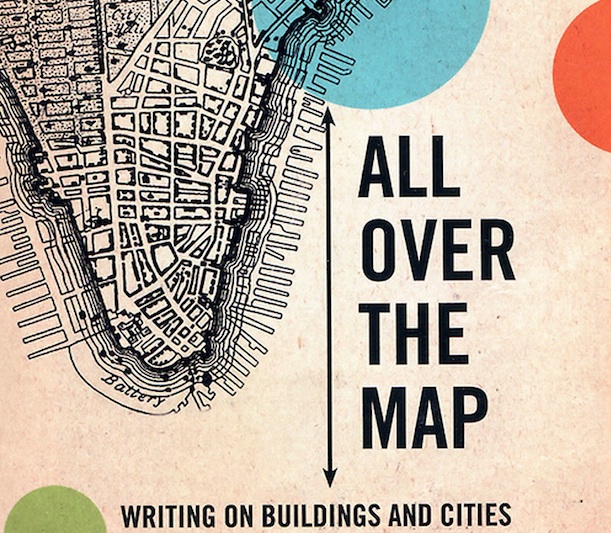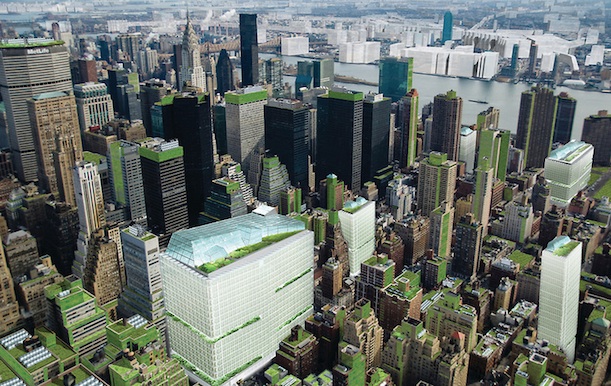The Design Future of New York as Seen by Urbanist Michael Sorkin
A theorist who can’t stop planning has big ideas for his hometown on sustainability, equity and the right to the city
![]()

Detail from the cover of All Over the Map: Writings on Buildings and Cities, 2011. Published by Verso. Copyright Michael Sorkin Studio.
Only Michael Sorkin, urban theorist and architect, could write an entire book about his 20-minute walk to work and turn it into an engaging meditation on city life and citizenship. Principal of Michael Sorkin Studio in New York as well as a professor at City College, Sorkin’s unique examination of what makes cities work has earned him the Cooper-Hewitt’s 2013 “Design Mind” Award. Sorkin says he’s honored to have won and has big plans for the celebratory lunch in October. “I have so much to discuss with the president and Michelle Obama,” the honorary patron of the awards.
Sorkin, who is often hard at work on entirely unsolicited plans to improve New York City, says he would like to talk to them about where to put the presidential library. “I think that they have an opportunity to do something much more than simply create a kind of memorial if they put it in the right neighborhood in Chicago,” says Sorkin. “It can be transformative for a neighborhood and not simply for an institution.” Hoping to reflect the kind of community organizing Obama once did in Chicago’s South Side, Sorkin says the building “could include schools and housing and medical facilities, something much broader, in the same way that the Carter Center seeks to have an influence in the world in geopolitical terms, I think that an exemplary project in neighborhood terms could be something fantastic.”
We caught up with the perpetual planner and ponderer in between projects:
You grew up in the D.C. area, what sort of impression did it leave?
I grew up in a very distinctive place, Hollin Hills, a suburban development in Fairfax County that was distinguished for its modernist architecture, designed by a very good D.C. architect, Charles Goodman, who is no longer with us. I have distinct memories of growing up in this glass house. Because it was developed starting in the late 40s, it attracted a particular kind of personality, so it was this little, liberal enclave in the midst of what was then the most progressive county in the United States, so there were strong bonds and interesting people.
The older I got in the 50s, the duller it became. My parents were both native New Yorkers so I looked forward with great anticipation to the holiday trips to see the grandparents in New York and that had an intoxicating smell.
You’ve written about what it takes to get that vitality. Why did New York seem to have more of that?
One of the problems in my childhood and in D.C. was the fact that it was a complete company town. Only after I left, did more than 50 percent of the employment fall into the non-government category, so things were kind of monochrome. It’s always been a very segregated city and some of my days were pre-Brown v. Board of Education. The Virginia schools were segregated, my parents sent me to a progressive school so I could have black playmates but all that was a bit weird to put it mildly.
Are you a New Yorker now?
Absolutely, yeah.
What does it mean to be a New Yorker?
It means that I don’t think I’ll ever choose to live anywhere else. It means being engaged with the politics of the city. It certainly means having a hopeful and active attitude towards the design of the city’s future. We’re always making unsolicited projects for improvements at various scales around New York.

Greening the city. New York City (Steady) State proposal, New York, NY. Photo: Terreform. Copyright Michael Sorkin Studio.
What’s new in New York?
One of things that’s been going on that I’ve been involved with lately is thinking about the city post-Sandy, which was an incredible wake-up call for the city and the region.
I am personally working on a project, which is an alternative master plan for New York, based on the radical idea of self-sufficiency. We asked ourselves the question five or six years ago whether it was possible for New York City to become completely self-sufficient.
We’ve done food and we’re on to movement, and climate, and energy, and construction, and so on.
What did you find on food?
That it is technically possible to grow 2,000 calories for everybody but would require, everybody’s favorite form: vertical skyscraper farms. We initially thought space was going to be the great inhibitor but if you do that you can probably accumulate enough space. The twin problems we detected are that the energy inputs are staggering, so we’ve estimated that if you wanted to make vertical farms and feed everybody within the political boundaries it would probably take the energy equivalent of 28 atomic power plants, which is not entirely contiguous with the spirit of the exercise. But also, since this thing is also a kind of critique of the mode of production of food and agribusiness–we’re all terribly artisanal and growing ramps in Brooklyn–how would you organize this very large-scale production in a way that wasn’t Monsanto dominated? We think about the condition of lofts and the possibilities of small scale agriculture inhabiting these larger spaces.
It is clear that there are a series of sweet spots that are practical. We’re looking at a scheme where about 30 percent of food production could be done. We’re also looking at schemes where the Erie Canal is revived and more production is done in-state.
What’s guiding design in New York now?
Unclear at the moment, good things have happened in New York in terms of bicycle infrastructure and a million trees planted on the other hand, the income gap gets bigger and bigger. There are 50,000 homeless now, a record. This is a pattern that seems to be characteristic of the United States as a whole. This is also unsustainable.
I think our crisis is to find a way to make the desirable aspects of urbanism, which are not obscure or mysterious, available to everyone in the city.
We don’t face a crisis of design imagination. I think there are lots of great designers and good ideas around. But we do face a crisis in equity.
Reviewing a 1992 book of essays you edited, Variations on a Theme Park about the disappearance of public space, Marshall Berman wrote that if readers accept what the book is saying, the “whole contemporary world turns out to be dreadful, totally alienated, inexorably evil.” Is it really so bad, is that your vision?
It isn’t. Marshall’s a good friend of mine, but he can be a bit of a sourpuss sometimes. That’s a book from a long time ago but I think the idea that all experiences are mediated by big capital, that Walt Disney or Facebook is creating the public space in which you function, is threatening to us all. There’s a lot of talk nowadays about the so-called right to the city, if you’ve read Lefebvre. My understanding or I think the correct understanding of that argument is both that we need access to the city, but we also need access to the possibility of imagining the city the we desire.
/https://tf-cmsv2-smithsonianmag-media.s3.amazonaws.com/accounts/headshot/Leah-Binkovitz-240.jpg)
/https://tf-cmsv2-smithsonianmag-media.s3.amazonaws.com/accounts/headshot/Leah-Binkovitz-240.jpg)